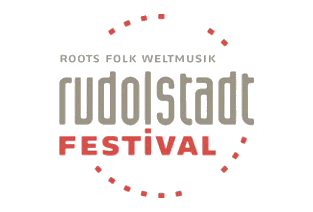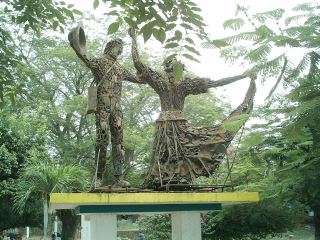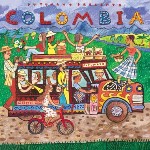
Carmelo Torres y su cumbia sabanera Edmar Castañeda Grupo de baile Otrora Boyacá Las Áñez & Martha Hincapie M.A.K.U. Soundsystem Paíto y los Gaiteros de Punta Brava Profetas Rancho Aparte Retrovisor Sidestepper
The Rudolstadt Festival, Germany’s biggest folk, roots and world music event, brings into focus Colombia and the Cumbia.
The music of Colombia is an expression of Colombian culture, which contains diverse music genres, both traditional and modern, according with the features of each geographic region, although it is not uncommon to find different musical styles in the same region. The diversity in musical expressions found in Colombia can be seen as the result of a mixture of African, native Indigenous, and European (especially Spanish) influences, as well as more modern American.
Colombia is known as "The land of a thousand rhythms" but actually holds over 1,025 folk rhythms.
Some of the best known genres are cumbia and vallenato. The most recognized interpreters of traditional Caribbean and Afrocolombian music are Totó la Momposina and Francisco Zumaqué.
Cumbia is a mixture of Spanish, Native Colombian and African music. The style of dance is designed to recall the shackles worn around the ankles of the slaves. In the 19th century, slavery was abolished and Africans, Indians and other ethnic groups got a more complete integration in the Colombian culture.
Cumbia is a complex, rhythmic music which arose on Colombia's Atlantic coast. In its original form, cumbia bands included only percussion and vocals; modern groups include saxophones, trumpets, keyboards and trombones as well. It evolved out of native influences, combining both traditions. Some observers have claimed that the dance originally associated with iron chains around the ankle. Others still believe that it is a direct import from Guinea, which has a popular dance form called cumbe.
Cumbia's form was solidified in the 1940s when it spread from the rural countryside to urban and middle-class audiences. Mambo, big band and porro brass band influences were combined by artists like Lucho Bermúdez to form a refined form of cumbia that soon entered the Golden Age of Cumbia during the 1950s. Discos Fuentes, the largest and most influential record label in the country, was founded during this time. Fruko, known as the Godfather of Salsa, introduced Cuban salsa to Colombia and helped bring Discos Fuentes to national prominence by finding artists like La Sonora Dinamita, who brought cumbia to Mexico, where it remains popular.
It is worth pointing out that the "classic" cumbia known throughout Colombia is the Cumbia Cienaguera. This song reflects a uniquely Colombian feel known as "sabor" (flavour) and "ambiente" (atmosphere). Arguably, this song has remained a Colombian staple through the years and is widely known as Colombia's unofficial national anthem. Some artists are Los Gaiteros de San Jacinto, Los Graduados, Los Black Stars, Los Golden Boys, Los Teen Agers, and Los Corraleros de Majagual.
Some Colombian communities, such as Chocó, Cartagena, San Andres and Providence Island, have large African-descendant communities. Unlike most of the country, cultural mixing with native and European influences have been rare, and, especially in El Chocó, music has changed little since being imported from West Africa. Providencia Island is also home to a type of folk music which is closely related to mento, a Jamaican folk form. Most influentially, however, is the city of Cartagena and its champeta music which has been influenced by soukous, compas, zouk, and reggae. Champeta musicians have included Luis Towers, El Afinaíto, El Sayayín, El Pupy, and Boogaloo, while others like Elio Boom have incorporated Jamaican raggamuffin music to champeta. Another noteworthy band is BIP, who originally did champeta music and currently are doing reggaeton, without leaving behind their champeta roots.

Porro bands are an enthusiastic form of big band music that came from Sucre, Córdoba and Sabana de Bolívar. The brass ensembles are modeled after European military bands. Influential porros include La Orquestra Lucho Bermudez, Matilde Diaz, Pacho Galan, Banda de 11 Enero, La Sonora Cordobesa, La Sonora Cienaguera, Orquesta Climaco Sarmiento and Pedro Laza y sus Pelayeros.
Actually Vallenato is not a rhythm. It is a Genre. It is made up of four rhythms: Son, Puya, Merengue and Paseo. Vallenato arose in Valledupar on Colombia's Atlantic Coast and only gained popularity elsewhere in the country in the 1980s. Its origins are shrouded in mystery but are said to have begun with Francisco el Hombre, who allegedly defeated Satan in a musical contest. Based around the accordion,the guacharaca, and the caja vallenata(a larger version of the bongo), vallenato has long been connected with cumbia. Influential artists include Alejo Duran and more recently, Alfredo Gutiérrez and Lisandro Meza. In addition to the accordion, the bass guitar has been a common part of vallenato ensembles since it was introduced by Caliya in the mid-1960s. The most recent modernization of vallenato occurred in 1993 when Carlos Vives released Clásicos de la Provincia, which made him into a star and changed the face of vallenato.
Vallenato has spawned several subgenres, including vallenato-protesta, which is known for socially aware lyrics, and charanga vallenata, which was invented by Cubans in the United States like progenitor Roberto Torres.
|
|

This is one of the most African influenced-styles in all of Colombia, and has its roots among the Afro-Colombian/African-descendant/Black people of the Pacific coast.
In its most basic form, the currulao is played by a group of four musicians.
One musician plays a 6-8 rhythm on a drum known as a "cununo", which superficially resembles the "alegre" drum (used in Cumbia) to the untrained eye, but is narrower and taller. The Currulao rhythm is created by both striking the skin of the drum with the one's hand and tapping the side of the drum with a small stick.
The second musician keeps time on a shaker known in parts of Colombia as a "guasá"(goo-ah-SAH) or "guache"(goo-AH-cheh), which is typically a hollow cylinder made of metal, wooden, or guadua bamboo, filled with light seeds, rice is sometimes used in home-made guasás.
But the main instrument of the currulao style is perhaps the Colombian marimba, a wooden xilophone which resembles the African balafon also for the style of playing.
Many groups in Colombia perform this traditional style of music. Currently, the most renowned groups include Grupo Socavón, Grupo Gualajó, and Grups Bahia Trio. A well renowned figure among the old marimbero masters in Colombia is Baudilio Cuama Rentería from Buenaventura Colombia.
In the United States two Colombian Bands performing this genre with authentic traditional instruments are La Cumbiamba NY, on the east coast (New York), and Aluna Band in the west coast (San Francisco). In 2010, Currulao has been added to the UNESCO list of Masterpieces of the Oral and Intangible Heritage of Humanity.
|
|
|
Bambuco is an indigenous form of music with European influence, sometimes known as Música del interior. Bambuco is said to have originated from the Muisca Indians due to it sad and slow rhythm. Its popularity has long been, but was extremely popular across Colombia from the mid-1920s to the late 1930s. Artists include Estudiantina, Los Carranguerros de Raquira, Jaime Llano González, Jorge Villamil, and the Morales Pino Trío.
|
|
Música llanera is a harp-led genre of music from Los Llanos popular throughout Colombia. It includes the traditional joropo musical style, and is known for verbal contests called contrapunteo. Artists in this genre include Alfredo Rolando Ortiz (born in Cuba), Alma Llanera (band), Grupo Cimarrón (band), Luis Ariel Rey, Carlos Rojas, Sabor Llanero, Arnulfo Briceño, and Orlando Valdemarra. This particular type of music is also popular in Venezuela due to the shared llanos. It is considered to be the national music of Venezuela. Listen joropo music .
|
|
|
|
Salsa music was born among Puerto Ricans and Cubans, but soon spread to Colombia. Native salsa groups like Fruko y sus Tesos and labels that recorded them like Discos Fuentes emerged. Artists like Joe Arroyo followed, inventing a distinctively Colombian form of salsa. Other influential Colombian salsa artists include Cristian Del Real "The Timbal Genius", Grupo Niche, Alquimia, La Misma Gente, Los Titanes, Los Nemus del Pacífico, Orquesta Guayacán, Grupo Galé and La Sonora Carruseles. Some of the most prolific composers in the genre are Jairo Varela and Nino Caicedo whose compositions have been recorded by Grupo Niche and Orquesta Guayacán respectively. Several Cuban and Puerto Rican musicians who have established in Colombia, such as Diego Valdés and Israel Tanenbaum, have collaborated with Colombians in salsa projects. Recently Colombian dancers have become World Champions year after year and the style is becoming more popular and admired among Salsa professionals worldwide; with two of the most prominent salsa schools being Swing Latino driven by the dance choreographer Eduardo 'El Mulato' Hernandez, and Constelación Latina driven by one of the world's most beloved dancers Jhoanna 'KKO' Agudelo. As a dance, Colombian Salsa is unique and different from New York/Puerto Rico and Cuban salsa. Colombian Salsa concentrates on footwork and does not incorporate cross-body leads. Dancers leave the upper part of the body still and relaxed while the feet do extremely fast and complex movements.
In the late 1950s, Mexican rock artists like Enrique Guzmán and César Costa became very popular in Colombia. Soon, native rock bands like Los Speakers and The Flippers gained a wide following. Starting in 1967 (see 1967 in music), native bands like Génesis (unrelated to the more famous band Genesis of a similar name) fused native musical forms (like cumbia) with rock. Marco, the voice of the Rock and Roll, was a pioneer and promoter of the "Rockabilly Colombian" performed with his unmistakable personal stamp in their own language. Virtuality is in their first recordings routed to the sensitive listener to enjoy the simplicity of rock bass, guitar and drums, combined into a whole to produce a very particular and in an atmosphere of a home recording studio, filled with reel tapes and three microphones mixed in mono line. (Marco Tulio Sanchez B) contributed to the Colombian rock and roll look to the past to remember our roots, dabbling in country and rockabilly music evokes Elvis Presley, is called today the "Elvis colombiano", awarded abroad for their ability on stage as a whole "Showman" and the unmistakable voice of Cronn rocker.
Rock in Colombia gained great popularity during the 1980s with the arrival of bands such as Soda Stereo (Argentina), Los Prisioneros (Chile), and Hombres G (Spain). During the 90's, many punk and heavy metal bands appeared in Bogotá, Medellín, and Cali. Colombia has possibly the biggest underground, hardcore, metal and punk movement of the continent, and is known in Latin America as the "punk corner". Aterciopelados, Kraken and Masacre are some of the most important Colombian rock bands.
The music event Rock al Parque celebrated yearly in Bogotá is the largest free Rock festival in Latin America; around 100 bands playing their music along 3 days and 400,000 people in attendance. Currently, Doctor Krápula, a rock band with strong ska influences that is known for making covers of traditional Latin American songs, enjoys great popularity. The most popular Colombian Rock band outside of Colombia is The Monas, winners of a Billboard Award and Mick Jagger's favorite Latin Rock Band. Aside from playing to sold out crowds from New York to Los Angeles, They played at SXSW festival in Austin, TX and to fifty thousand people at the Latin Grammys in L.A. The Monas have played with Rage Against The Machine, Iggy Pop, The Presidents of The United States of America, Bowling for Soup, La Secta, Lucybell and others.
Other popular and interesting bands are Ekhymosis, a group led by Juanes, who began making music in 1988 and are known for doing Rock with a Colombian influence, The Hall Effect who make English pop/rock linked with Britpop influences. SOUNDACITY a mix of Brit Rock, Pop and Andean sounds, rhythms and instrumentation, sing both in English and Spanish and have toured the United States east coast. Proper Strangers avant-garde rock. Two Way Analog an eclectic band whose influence are roadmovies and its soundtracks, Divagash electronic soft-rock, La Pestilencia post-hardcore, Bajo Tierra, Palenke Soultribe (traditional Colombin roots music fused with electronic beats). But, possibly, the most successful "indie" band is Sidestepper, with its fusion of Colombian traditional music, electronic and African rhythms, who already appeared in Coachella Festival in 2006. Some musical groups in the death metal genre are the world famous Internal Suffering, Carnivore Diprosopus, Goretrade, Mindly Rotten, Suppuration, and Amputated Genitals. Colombia is also the birthplace of the well known black metal band Inquisition, now based in Seattle, Washington. Miguel Fernando Trapezaris, the bassist of Cyprus-based Epic power metal band Winter's Verge, is of Colombian descent.
This musical genre has been growing recently with artists like Los de Adentro, San Alejo, Sebastian Yepes, Lucas Arnau or Mauricio & Palodeagua. Pop with strong traces of traditional Colombian music, named Tropipop, is also rising currently. Fonseca and Maía represent this trend.
Some of Colombia's most internationally recognized artists include the following:
Hip Hop came to Colombia in the late 1980s when a few US Hip-Hop tracks by NWA and MC Hammer spurred a break-dancing fever among the young of the less privileged areas of major cities such as Medellín, Cali and Bogotá. Towards the end of this decade groups began to form, eventually leading to complete album productions in the mid-1990s. La Etnia and Gotas de Rap were two of the various hip-hop groups that emerged and are widely considered as the pioneers of Colombian Rap. Promoting a very independent style, both groups expressed extreme political and social views, protesting violence, corruption, inequality and hardships in the marginalized regions of Colombia. Then Asilo 38 from Cali come onto the scene with the albums, La Hoguera (2000) and La Descarga (2002), presenting a more commercial and polished sound, while still retaining strong socio-political messages.
2006 brings a renaissance in Colombian Hip-Hop in the form of Afro-Colombian group ChocQuibTown, fusing traditional rhythms and instruments from their native lands in the Colombian Pacific into their sound. Already hailed as the new phenemomenon in Colombian Hip-Hop, their popularity is ever increasing and making way for other Urban artists to emerge. One such artist is Jiggy Drama, from the island of San Andres, who has become one of the most loved and controversial rap artist in Colombia, his lyrics are spicy and intelligent. Jiggy Drama collaborated with Colombian Party Cartel on the urban merengue track "Chico Malo". *On the international stage Aztek Escobar based in Houston, Colombian Party Cartel based in Nashville, Tres Coronas based in New York, Adassa based in Miami and 3 of the seven-man group of Culcha Candela in Berlin, Germany are representing Colombian urban music worldwide.

Text is available under the Creative Commons Attribution-ShareAlike License.
Date: February 2016.
Photo Credits:
(1) Rudolstadt Festival,
(2),(6) La Chiva Gantiva,
(3) Monument to the dance and music of cumbia in El Banco,
(4) LP Cover (unknown/website);
(5) Monsieur Perine
(by Christian Moll).